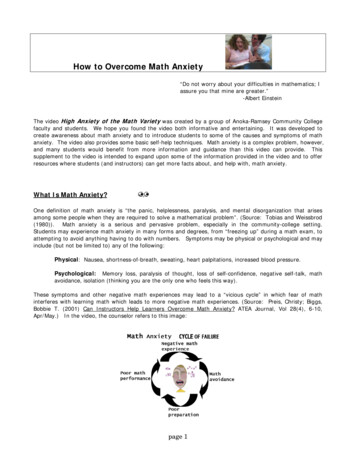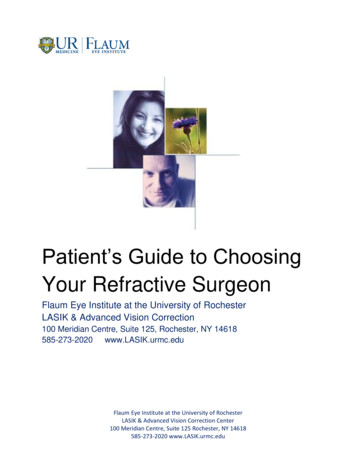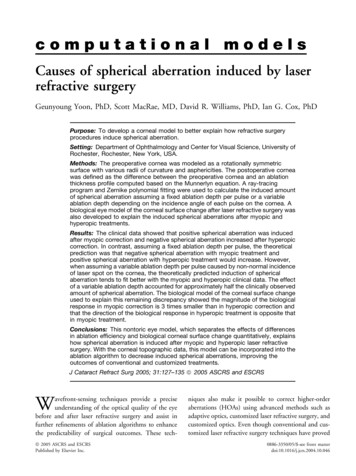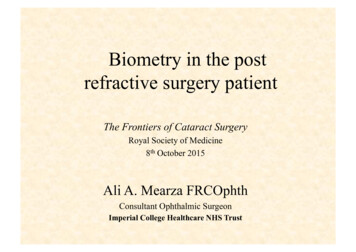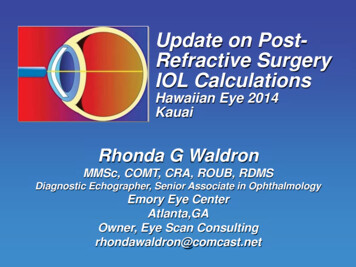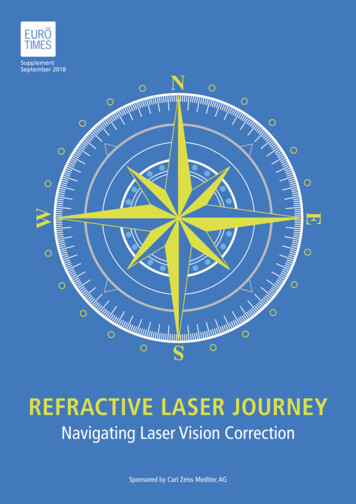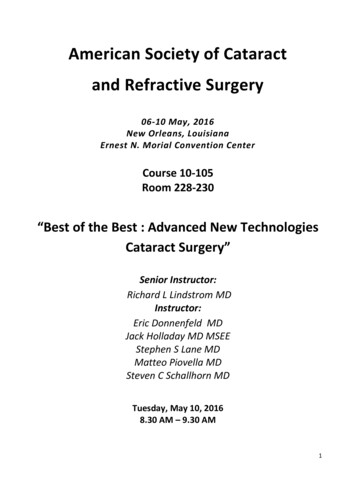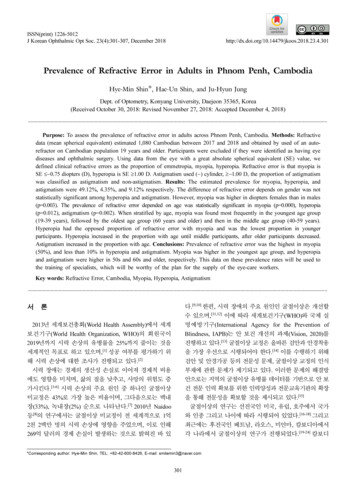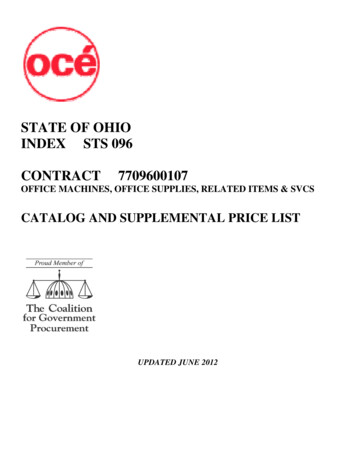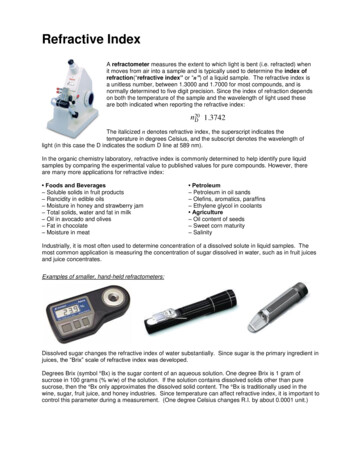
Transcription
Refractive IndexA refractometer measures the extent to which light is bent (i.e. refracted) whenit moves from air into a sample and is typically used to determine the index ofrefraction(“refractive index” or “n”) of a liquid sample. The refractive index isa unitless number, between 1.3000 and 1.7000 for most compounds, and isnormally determined to five digit precision. Since the index of refraction dependson both the temperature of the sample and the wavelength of light used theseare both indicated when reporting the refractive index:The italicized n denotes refractive index, the superscript indicates thetemperature in degrees Celsius, and the subscript denotes the wavelength oflight (in this case the D indicates the sodium D line at 589 nm).In the organic chemistry laboratory, refractive index is commonly determined to help identify pure liquidsamples by comparing the experimental value to published values for pure compounds. However, thereare many more applications for refractive index: Foods and Beverages– Soluble solids in fruit products– Rancidity in edible oils– Moisture in honey and strawberry jam– Total solids, water and fat in milk– Oil in avocado and olives– Fat in chocolate– Moisture in meat Petroleum– Petroleum in oil sands– Olefins, aromatics, paraffins– Ethylene glycol in coolants Agriculture– Oil content of seeds– Sweet corn maturity– SalinityIndustrially, it is most often used to determine concentration of a dissolved solute in liquid samples. Themost common application is measuring the concentration of sugar dissolved in water, such as in fruit juicesand juice concentrates.Examples of smaller, hand-held refractometers:Dissolved sugar changes the refractive index of water substantially. Since sugar is the primary ingredient injuices, the “Brix” scale of refractive index was developed.Degrees Brix (symbol Bx) is the sugar content of an aqueous solution. One degree Brix is 1 gram ofsucrose in 100 grams (% w/w) of the solution. If the solution contains dissolved solids other than puresucrose, then the Bx only approximates the dissolved solid content. The Bx is traditionally used in thewine, sugar, fruit juice, and honey industries. Since temperature can affect refractive index, it is important tocontrol this parameter during a measurement. (One degree Celsius changes R.I. by about 0.0001 unit.)
When a sugar solution is measured by refractometer or densitometer, the R.I. or Bx value only representsthe amount of dry solids dissolved in the sample if the dry solids are exclusively sucrose. This is seldom thecase. Grape juice, for example, contains little sucrose but does contain glucose, fructose, acids and othersubstances. In such cases the Bx value clearly cannot be equated with the sucrose content but it may
represent a good approximation to the total sugar content. For example, an 11.0 %w/w D-Glucose ("grapesugar") solution measures 10.9 Bx.When other solids are dissolved in the solution, they can affect the refractive index. For example, many fruitjuices contain citric acid that will increase the Brix value. Therefore, the citric acid is usually titrated and thebrix value is corrected from values in published tables.Note the differences in sugar concentrations between orange, grape, and lemon juices. When importedjuices arrive (usually as juice concentrates), they are tested by U.S. Customs and the “Brix” value must meetthe respective specification in the following table. The values in the lower part of the table are the actualrefractometer readings that represent the typical combined citric acid and sugars.When juice bottlers manufacture a fruit juice beverage, they purchase frozen juice concentrates on thecommodities market. The cost of these juices depends on their Brix value. The higher the Brix value, themore concentrated the juice. The concentrates save on shipping and refrigeration costs. The concentratesare diluted with water to the appropriate ratio as determined by the Brix numbers, and the resulting product ispasteurized, filled, and sealed for sale.US CUSTOMS TABLE OF CORRECTED BRIX VALUES FOR SELECTED JUICES*GRAPEDEGREE OFORANGELEMON JUICE[VITIS VINIFERA]CONCENTRATIONJUICEJUICEUnconcentrated(No Citric acid correction)R.I Reading ( 06.57.0- 17.3117.32 - 19.9719.98 - 25.1425.15 - 30.0930.10 - 34.8534.86 - 39.4239.43 - 43.8343.84 - 48.0748.08 - 52.1752.18 - 56.1256.13 - 59.9559.96 - 63.6563.66 - 67.2521.5- 30.9931.00 - 35.4735.48 - 43.9543.96 - 51.8651.87 - 59.2759.28 - 66.2366.24 - 72.8172.82 - 79.0379.04 - 84.9584.96 - 90.95———8.9- 13.1213.13 - 15.1815.19 - 19.2119.22 - 23.1023.11 - 26.8726.88 - 30.5330.54 - 34.0934.10 - 37.5437.55 - 40.8940.90 - 44.1544.16 - 47.3247.33 - 50.4050.41 - 53.41*Note: Brix correction (0.1775 x % anhydrous citric acid) 0.1343Some industries utilize the Brix scale to measure solute concentrations thatcontain no sugar at all. Of course, in this case the brix scale is similar tothe refractive index just a number that can be calibrated to the specificanalytical method. A series of standards in prepared, measured, and thenplotted. When an unknown containing the same solute is analyzed, thereading is compared to the chart to obtain the actual concentration.For example, the concentration of salt solutions or antifreeze can be easilymeasured by refractive index. However, alcohol water mixtures are not aseasy. Note the refractive index values of the mixtures in the table below.Also note the density of ethanol and methanol in the same solutions.Relationship between SaltSolution and SugarConcentration (Brix) andrefractive index at 20 41.375927.1251.377828.1261.379729.2Brix %
.00% Organic 2590.82040.81480.80890.80340.79760.7917Ethylene 1.38111.38511.38921.3931Refractive Index of Selected CoolantSolutionsEthanolEthylene 1.39521.3995GlycerolPropylene GlycolMethanol% .06701.07191.0765Density of 040.0060.0080.00% Organic (w/w)Honey contains a lot of sugar that can be determined by refractive index. Notice that the plot below shows therefractive index as a function of water (not sugar) in the mixture. Hence, a negative slope is observed. Theconcentration of the sugars is calculated as the remainder (100% - % water % sugar).100.00
Calibration of the refractometer is important. While published values are helpful, it is critical to insure theinstrument is measuring values correctly. Liquid solutions are prepared or purchased that are measured underthe same conditions as the samples. Here is an actual example of a test for glycerin (glycerol) in water. Fourstandards were prepared by weighing out the appropriate masses of glycerin and water, preparingconcentrations of 70%, 80%, 90%, and 100%(w/w). These were measured on the Abby refractometer on acold day in the lab and the values differ slightly from the published values.Refractive Index Calibration of Glycerin/Water Mixtures (Brix Scale)%(w/w) Bx Bx Calibration0.0%0.0Slope73.5970.0%53.2 own Mixture of Glycerin in Water:60.0 BxTrial #1Trial #2Trial #3% Gycerin54.873.8%54.773.7%54.873.8% Bxy 65.4x 7.56R² 0.999270.065.055.050.070.0% 80.0% 90.0% 100.0%End of Document
Refractive Index A refractometer measures the extent to which light is bent (i.e. refracted) when it moves from air into a sample and is typically used to determine the index of refraction(“refractive index” or “n”) of a liquid sample.The refractive index is a unitless num

